
New Alpine Frost Fragrance Oil will be your go-to winter scent. The notes of eucalyptus, sparkling icicle, amber, and musk inspired this cold process soap.
The blue and white color palette complements the fragrance perfectly. Soap colored with Ultramarine Blue Pigment, Neon Blue Raspberry Colorant, and titanium dioxide are poured into the mold with a drop swirl technique. A Hanger Swirl Tool is used to create a more intricate design. The best part is you don’t have to be too careful with the design and each bar will look unique.

What You Need: Click below to add everything you need for this project to your Bramble Berry shopping cart!Alpine Swirl Cold Process Soap
10″ Silicone Loaf Mold
Hanger Swirl Tool
3.5 oz. Avocado Oil (10%)
1 oz. Castor Oil (2.8%)
8.8 oz. Coconut Oil (25.1%)
8.8 oz. Olive Oil (25.1%)
8.8 oz. Palm Oil (25.1%)
4.2 oz. Rice Bran Oil (12%)
4.9 oz. Sodium Hydroxide Lye
10.4 oz. Distilled Water (10% water discount)
1.75 oz. Alpine Frost Fragrance Oil
Titanium Dioxide
Ultramarine Blue Pigment
Neon Blue Raspberry Colorant
If you’ve never made cold process soap before, stop here. We highly recommend checking out our FREE four part SoapQueen.tv series on cold process soapmaking, especially the episode on lye safety. And if you’d rather do some reading, Bramble Berry carries a wide range of books on the topic, including Pure Soapmaking.
COLORANT PREP: Disperse 1 teaspoon of titanium dioxide into 1 tablespoon of a lightweight liquid oil such as sunflower or sweet almond. Then in separate containers, disperse 1 teaspoon of Ultramarine Blue Pigment and 1 teaspoon of Neon Blue Raspberry Colorant into 1 tablespoon lightweight liquid oil. Use a mini mixer to get rid of clumps.
Optional: To ensure the titanium dioxide blends smoothly into the soap, we recommend micronizing it before dispersing it in oil. Use a coffee grinder to break up any clumps of color and prevent streaks of white from showing in the final soap. We like to use a coffee grinder that has a removable stainless steel mixing area for easy cleaning.
FRAGRANCE PREP: In a glass fragrance oil-safe container, measure out 1.75 ounces of Alpine Frost Fragrance Oil and set aside.
SAFETY FIRST: Suit up for safe handling practices. That means goggles, gloves, and long sleeves. Make sure kids, pets, other distractions, and tripping hazards are out of the house or don’t have access to your soaping space. Always soap in a well-ventilated area.
ONE: Slowly and carefully add 4.9 ounces of lye to 10.4 ounces of distilled water. Gently stir until the lye has fully dissolved. Set it aside to cool. If you’d like a harder bar of soap that releases faster from the mold, you can add sodium lactate to the cooled lye water. Use 1 teaspoon of sodium lactate per pound of oils in the recipe. For this recipe, you’d add 2 teaspoons sodium lactate.
TWO: Melt and combine 3.5 ounces of avocado oil, 1 ounce of castor oil, 8.8 ounces of coconut oil, 8.8 ounces of olive oil, 8.8 ounces of palm oil (remember to fully melt the entire container of palm oil before portioning), and 4.2 ounces of rice bran oil into a large mixing bowl. Once the lye water and the oils have cooled to 130 degrees F or below (and are ideally within 10 degrees of each other), add the lye water to the oils and stick blend the mixture to a very thin trace.

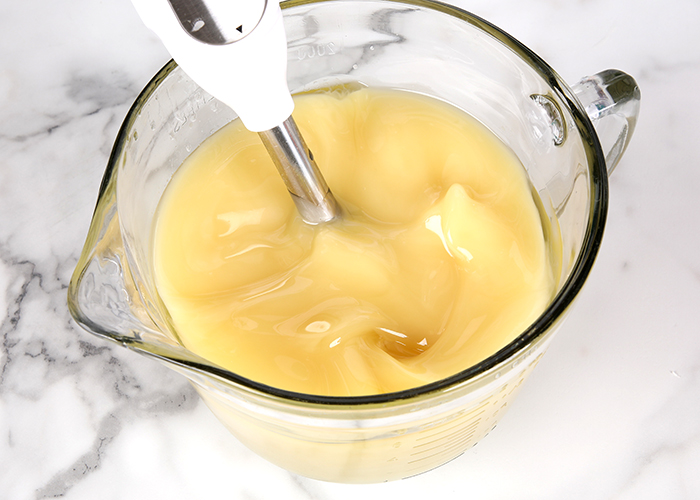 THREE: Split the soap into three separate containers and add the following colors. Use a whisk to mix them in.
THREE: Split the soap into three separate containers and add the following colors. Use a whisk to mix them in.
- Container A (300 mL ): 1.5 teaspoons dispersed Neon Blue Raspberry Colorant
- Container B (300 mL): 2 teaspoons dispersed Ultramarine Blue Pigment
- Container C (remaining soap): All dispersed titanium dioxide

 FOUR: Add the 1.75 ounces of Alpine Frost Fragrance Oil to each container proportionally – it’s okay to eyeball it. Use a whisk to mix in the fragrance.
FOUR: Add the 1.75 ounces of Alpine Frost Fragrance Oil to each container proportionally – it’s okay to eyeball it. Use a whisk to mix in the fragrance.
 FIVE: Pour a small amount of the white soap into the mold – just enough to cover the bottom. Then alternate pouring small amounts of the dark blue, white, and light blue soap into the mold at varying heights. That helps the soap drop to different areas of the mold rather than sitting on top and creating layers. Don’t worry about being too precise when you’re pouring.
FIVE: Pour a small amount of the white soap into the mold – just enough to cover the bottom. Then alternate pouring small amounts of the dark blue, white, and light blue soap into the mold at varying heights. That helps the soap drop to different areas of the mold rather than sitting on top and creating layers. Don’t worry about being too precise when you’re pouring.
Tip: Pouring white soap between the two shades of blue helps define the swirls.
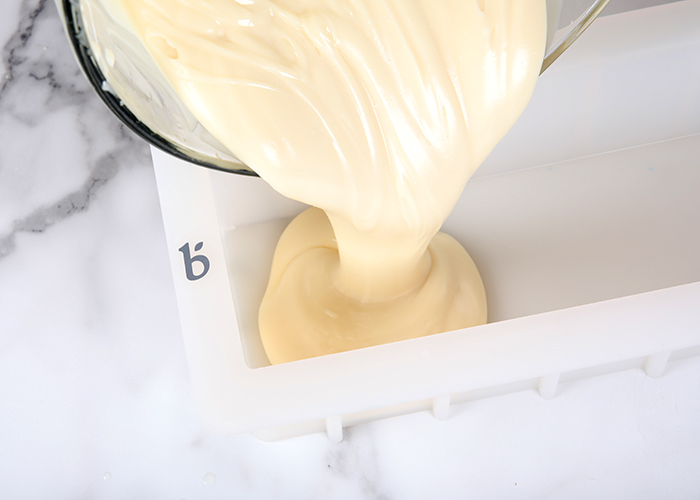

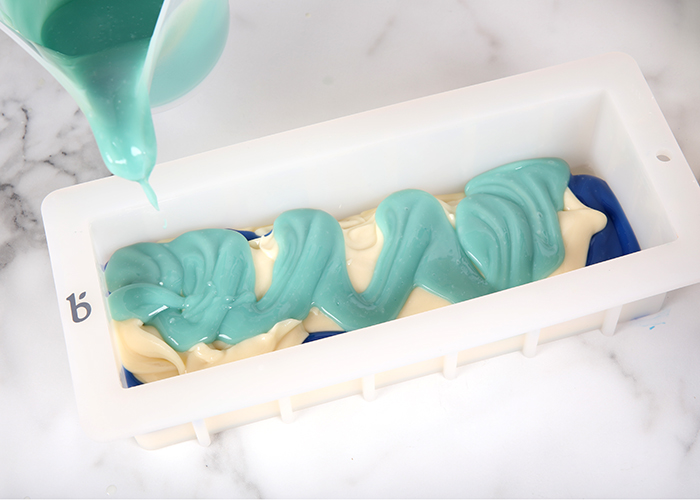 SIX: Continue pouring the soap into the mold. Save a very small amount of each color for the top.
SIX: Continue pouring the soap into the mold. Save a very small amount of each color for the top.
 SEVEN: Insert the Hanger Swirl Tool into one side of the mold. Then, use loop-de-loop motions to swirl the soap. There is no right or wrong way to do this necessarily, but different motions and patterns will result in slightly different looking swirl. Some loops should be big and some small. Varying the direction (horizontal versus vertical) also creates a more complex swirl. Once you’ve swirled the soap about 7-10 times, remove the Hanger Swirl Tool by bringing it up and out on one side of the mold.
SEVEN: Insert the Hanger Swirl Tool into one side of the mold. Then, use loop-de-loop motions to swirl the soap. There is no right or wrong way to do this necessarily, but different motions and patterns will result in slightly different looking swirl. Some loops should be big and some small. Varying the direction (horizontal versus vertical) also creates a more complex swirl. Once you’ve swirled the soap about 7-10 times, remove the Hanger Swirl Tool by bringing it up and out on one side of the mold.

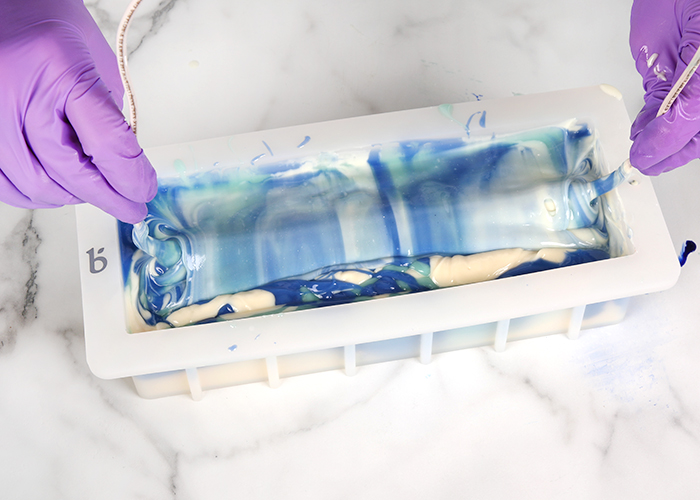 EIGHT: Pour or plop (depending on your trace – ours was quite thick at this point) dollops of the remaining soap on top. Don’t worry too much about the placement of each color.
EIGHT: Pour or plop (depending on your trace – ours was quite thick at this point) dollops of the remaining soap on top. Don’t worry too much about the placement of each color.
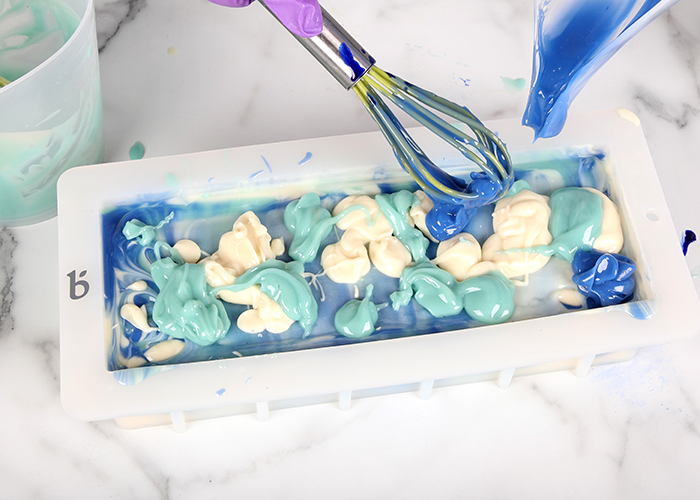 NINE: Use the back of a spoon to create peaks and divots into the soap. Have fun with the texture – there is no right or wrong way to do it. Watch this video for cold process soap texture inspiration.
NINE: Use the back of a spoon to create peaks and divots into the soap. Have fun with the texture – there is no right or wrong way to do it. Watch this video for cold process soap texture inspiration.
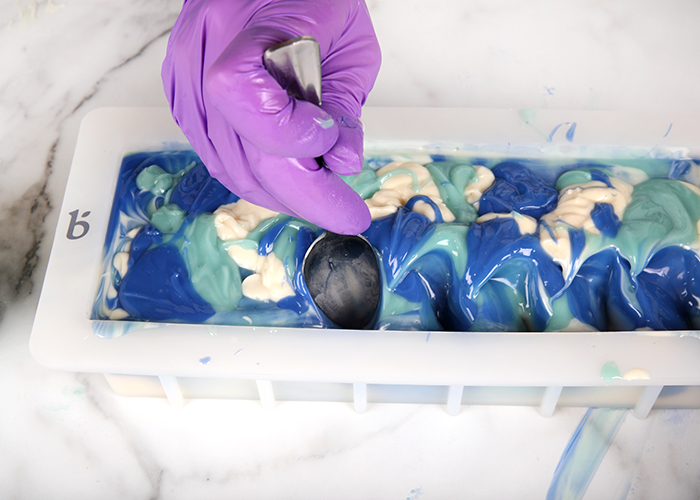
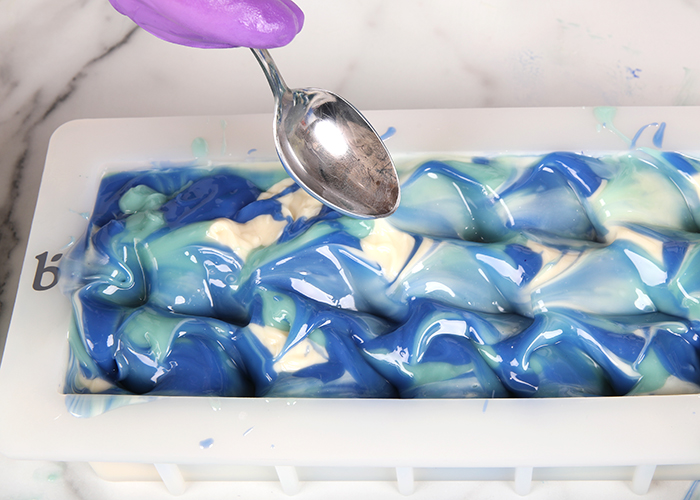 TEN: Once you’re happy with the top, spritz with 99% isopropyl alcohol. We placed this soap on a heating pad for about 1 hour to help promote gel phase. Allow the soap to stay in the mold for 1-3 days (depending if you used sodium lactate or not). Unmold and cut into bars. Allow the bars to cure for 4-6 weeks and enjoy!
TEN: Once you’re happy with the top, spritz with 99% isopropyl alcohol. We placed this soap on a heating pad for about 1 hour to help promote gel phase. Allow the soap to stay in the mold for 1-3 days (depending if you used sodium lactate or not). Unmold and cut into bars. Allow the bars to cure for 4-6 weeks and enjoy!
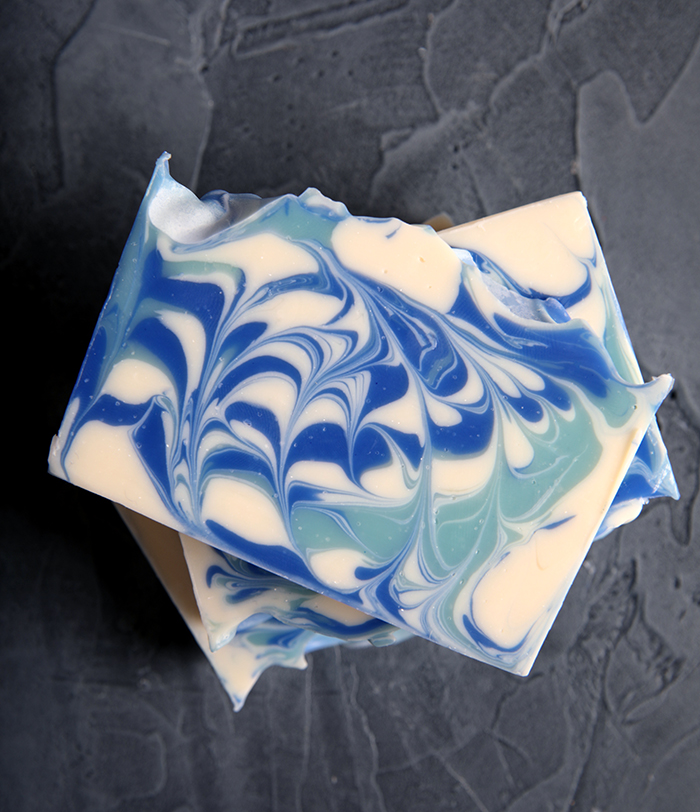
- 10″ Silicone Loaf Mold
- Hanger Swirl Tool
- 3.5 oz. Avocado Oil (10%)
- 1 oz. Castor Oil (2.8%)
- 8.8 oz. Coconut Oil (25.1%)
- 8.8 oz. Olive Oil (25.1%)
- 8.8 oz. Palm Oil (25.1%)
- 4.2 oz. Rice Bran Oil (12%)
- 4.9 oz. Sodium Hydroxide Lye
- 10.4 oz. Distilled Water (10% water discount)
- 1.75 oz. Alpine Frost Fragrance Oil
- Titanium Dioxide
- Ultramarine Blue Pigment
- Neon Blue Raspberry Colorant
- Slowly and carefully add 4.9 ounces of lye to 10.4 ounces of distilled water. Gently stir until the lye has fully dissolved. Set it aside to cool. If you’d like a harder bar of soap that releases faster from the mold, you can add sodium lactate to the cooled lye water. Use 1 teaspoon of sodium lactate per pound of oils in the recipe. For this recipe, you’d add 2 teaspoons sodium lactate.
- Melt and combine 3.5 ounces of avocado oil, 1 ounce of castor oil, 8.8 ounces of coconut oil, 8.8 ounces of olive oil, 8.8 ounces of palm oil (remember to fully melt the entire container of palm oil before portioning), and 4.2 ounces of rice bran oil into a large mixing bowl. Once the lye water and the oils have cooled to 130 degrees F or below (and are ideally within 10 degrees of each other), add the lye water to the oils and stick blend the mixture to a very thin trace.
- Split the soap into three separate containers and add the following colors. Use a whisk to mix them in.
Container A (300 mL ): 1.5 teaspoons dispersed Neon Blue Raspberry Colorant
Container B (300 mL): 2 teaspoons dispersed Ultramarine Blue Pigment
Container C (remaining soap): All dispersed titanium dioxide - Add the 1.75 ounces of Alpine Frost Fragrance Oil to each container proportionally – it’s okay to eyeball it. Use a whisk to mix in the fragrance.
- Pour a small amount of the white soap into the mold – just enough to cover the bottom. Then alternate pouring small amounts of the dark blue, white, and light blue soap into the mold at varying heights. That helps the soap drop to different areas of the mold rather than sitting on top and creating layers. Don’t worry about being too precise when you’re pouring. Tip: Pouring white soap between the two shades of blue helps define the swirls.
- Continue pouring the soap into the mold. Save a very small amount of each color for the top.
- Insert the Hanger Swirl Tool into one side of the mold. Then, use loop-de-loop motions to swirl the soap. There is no right or wrong way to do this necessarily, but different motions and patterns will result in slightly different looking swirl. Some loops should be big and some small. Varying the direction (horizontal versus vertical) also creates a more complex swirl. Once you’ve swirled the soap about 7-10 times, remove the Hanger Swirl Tool by bringing it up and out on one side of the mold.
- Pour or plop (depending on your trace – ours was quite thick at this point) dollops of the remaining soap on top. Don’t worry too much about the placement of each color.
- Use the back of a spoon to create peaks and divots into the soap. Have fun with the texture – there is no right or wrong way to do it.
- Once you’re happy with the top, spritz with 99% isopropyl alcohol. We placed this soap on a heating pad for about 1 hour to help promote gel phase. Allow the soap to stay in the mold for 1-3 days (depending if you used sodium lactate or not). Unmold and cut into bars. Allow the bars to cure for 4-6 weeks and enjoy!











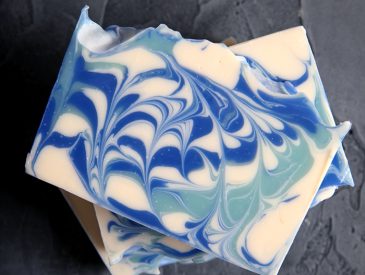


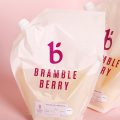


I just made this today and did everything correct according to the directions. As soon as I put in the fragrance, it immediately hardened! There was no way to pour it. So, it became sort of a plop soap using hands. This is way to thick! How do you handle this? Can the lye go bad? What do you think the problem is? Please help!
That’s strange! While the Alpine Frost Fragrance Oil mildly accelerates it should not seize the soap. Though it can thicken dramatically if stick blended in, you’ll want to make sure you are hand whisking the FO in.
Also, this recipe has a pretty high % of solid oils so if your temperatures were getting too low you might have experienced the oils solidifying which can also lead to false trace.
Thank you very much. I will try again.
Hello .I have a question.If my lye purity is lower or higher than the one sold at brambleberry do I need to adjust my recepie specifically to that lye through your lye cal or it doesn’t matter?One last question when your mixing oils and colorants such as micas( you said to use light weight oil and mix it in a separate container) is this oil accounted for in the recepie( total oil) or just some extra? Please answer
Yes, you would want to adjust the superfat level to allow for a higher concentration. For a lower concentration we don’t really have a way to show that at this time. The oil when mixing colorants is considered extra, since it is not a lot we don’t worry about including it in the recipe.
Hello,
In Argentina we dont have rice bran oil, for swirls which could be a good recipe? Thank you so much!
Graciana
You can use other lightweight oils like Apricot Kernal, Sunflower, or Sweet Almond.
Hello, Soap Queen TV! May I ask if I can add the melted BTMS 50 to cold processed soap as shampoo bar? Will it be okay? Will it add conditioning properties as the shampoo bar still needs ACV rinse? Thanks and Have a Good Day! 🙂
We’ve never tried adding BTMS-50 to a shampoo bar, it’s typically used more in conditioner recipes. We recommend doing a small test batch first to see if you like the results.
Such a beautiful blue color!
Ben is right! Just ran this through the soap calculator and it is 12.9% short of a full recipe…
Thanks for catching that mistake, we updated the post with the correct amount.
The recipe says 12% palm oil but 8.8oz same as the 25% olive and coconut?
Thanks for catching that mistake, we updated the post with the correct amount.
I am loving BB’s hanger swirl tool! I tend to take my trace a little too far for the drop swirls, and this tool allows me to still make wonderful swirls. What’s even better is my loves them too!